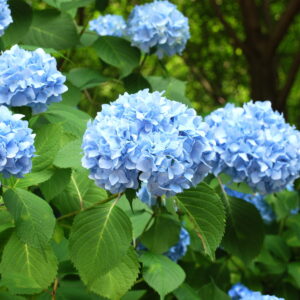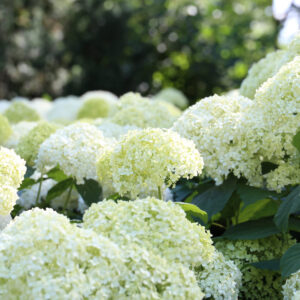Showing all 2 results
Wholesale Hydrangea for Sale in Michigan
When it comes to classic garden plants, nothing will turn heads and draw eyes like the illustrious hydrangea shrub. Popular for their large, round, and colorful flower heads, hydrangeas will add showstopping beauty to any landscape. Because of their quick growth, expansive size, and long-lasting blooms, they’re an ideal foundational plant for gardens big and small.
Hydrangea shrubs can grow up to 15 feet in height and 10 feet wide. Their flowers bloom in spring and last through the summer and early to mid-fall, classifying them as a perennial plant. Hydrangeas are low-maintenance and easy to grow in the right conditions, making them a must-have option for nurseries to offer customers throughout the country.
Different Types of Hydrangeas
There are two different categories of hydrangeas. Each category includes several different species, which themselves come in a wide variety of different cultivars.
New-Growth Hydrangeas
New-growth hydrangeas bloom on stems from the current year (new growth). Two different species of hydrangea fall into this category:
- Smooth hydrangea (Hydrangea aborenscens)—has smaller flowers than other hydrangea varieties, flowers bloom in clusters and start off green in early growing season before maturing to white, good for colder climates but is also heat tolerant, hardiness zones 4-9
- Panicle hydrangea (Hydrangea paniculata)—flowers bloom on long panicles in a cone shape (instead of typical hydrangea bulb-like clusters), flowers are white in early season and may turn pink as they mature, most cold hardy of the hydrangea plants, most popular variety is Pee Gee hydrangea, hardiness zones 4-7
Old-Growth Hydrangeas
Old-growth hydrangeas bloom on stems from the previous year (old growth). Several different species of hydrangea and their various cultivars fall into this category:
- Bigleaf hydrangea (Hydrangea macrophylla)—most common type of hydrangea with two main types:
- Mophead hydrangea: most recognizable variety, large, bulbous flower heads can be pink, purple, or blue, more sensitive to cold, thrive in hardiness zone 6
- Lacecap hydrangea: very similar to mophead variety, blooms have small, fertile buds in the center that are surrounded by showy sterile flowers to attract pollinators, half-bloomed look, thrive in hardiness zone 6
- Mountain hydrangea (Hydrangea serrata)—often included in the bigleaf category, similar look to lacecap hydrangeas but with smaller leaves and flower buds, hardier than most other varieties, ideal hydrangea for colder climates, thrive in hardiness zone 5
- Oakleaf hydrangea (Hydrangea quercifolia)—named for its foliage shaped like the leaves of an oak tree, cone-shaped flower heads, flowers start season white, then turn pink, then turn shades of red, orange, or gold in the fall, sensitive to waterlog but hardiest of old-growth hydrangeas, hardiness zones 5-9
- Climbing hydrangea (Hydrangea anomala, subspecies Hydrangea petiolaris)—grows on a vine, flowers are white and similar bloom to lacecap, more tolerant of partial shade, can be grown as a shrub if there is no strong support system for upward growth
How to Grow Hydrangeas
Hydrangeas should be planted in fall or early spring to allow the root system enough time to develop. Once established, hydrangeas grow rapidly (approximately 24 inches of growth per year). This shrub can adapt to a wide range of different growing conditions, as long as they have proper care.
Soil Conditions for Hydrangea
Hydrangeas thrive in fertile, well-drained but still moist soil. Most species of hydrangea cannot tolerate waterlog, so proper drainage is essential. Soil should be nutrient-rich and can be acidic or alkaline. Some varieties of bigleaf hydrangea will change flower color depending on soil acidity. Plant shrubs in soil with a pH of less than 5.5 for blue flowers or soil with a pH of greater than 5.5 for pink flowers.
Light Conditions for Hydrangea
Hydrangeas can thrive in partial or full sun. Too much shade will decrease flowering. Depending on the species of hydrangea and your climate, sun tolerance can range more specifically. Research the sun tolerance of your variety before choosing a planting location.
Planting Hydrangeas
The hole in which you plant your hydrangea shrub should be dug to the same depth as the root ball, so the plant sits level, and 2-3 times as wide. Avoid planting hydrangea under trees, as competition for soil and sun may inhibit growth. Space multiple hydrangea shrubs 3-10 feet apart (depending on the average size of your particular species) to leave enough room for growth.
Ongoing Hydrangea Maintenance
Hydrangeas are considered low to medium-maintenance shrubs. As long as they have the proper amount of moisture and nutrients in their soil and enough sun exposure, hydrangeas can live for up to 50 years.
Fertilizing Hydrangeas
If your hydrangea shrubs are planted in rich soil, they do not need any extra fertilizer. Too much fertilizer will cause abundant leaf growth, but at the cost of decreased flower bloom. For soils that can benefit from added fertilizer, time and frequency of application will depend on your specific hydrangea species.
Watering Hydrangeas
Throughout the growing season, hydrangeas should receive approximately one inch of water per week, or even two during hotter and drier periods. Deep watering three times per week, as opposed to more frequent shallow watering, will be optimal for root growth. Try to water your hydrangeas in the morning to prepare them for the afternoon heat. The use of organic mulch will help retain soil moisture, keep soil cool, and provide more nutrients—just be careful not to over-mulch and waterlog the roots.
Pruning Hydrangeas
If they have enough room to grow, hydrangea shrubs require minimal pruning. You may deadhead hydrangeas through early fall to encourage longer blooming. If you do need to trim back hydrangeas, cut one or two of the oldest stems at the base. For old-growth species, prune in mid-summer after they have bloomed. For new-growths, prune in late winter before the spring growing season.
Cold Stream Farm has the most popular species of new and old-growth hydrangeas available for delivery throughout the continental U.S. or pickup from our nursery in Free Soil, Michigan. Buy hydrangea shrubs for your nursery or other plant business in bulk at affordable wholesale prices or individually at retail price for home and property owners. Like our other deciduous shrubs, hydrangea shrubs can be grown as bare root seedlings or transplants.
Create an account today to place your order!



